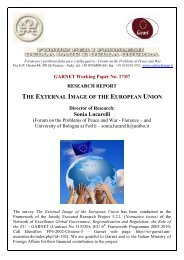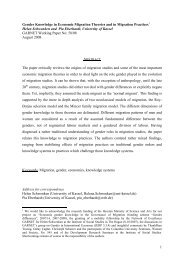GARNET Working Paper No. 13/07
GARNET Working Paper No. 13/07
GARNET Working Paper No. 13/07
Create successful ePaper yourself
Turn your PDF publications into a flip-book with our unique Google optimized e-Paper software.
militarized disputes and insecurity. Most and Starr, for instance, have demonstrated with<br />
substantial empirical data, that if a war begins on a nation’s border, that nation might then<br />
become involved in a new military conflict depending upon the perceived changes in the<br />
nation’s vulnerability, uncertainty, risks, and opportunities that accompany the onset of the<br />
military conflict. In general they assume that the likelihood of diffusion is particularly high<br />
among states in a region because such states interact more extensively than other states<br />
(1980:936). Likewise, Hammaström and Heldt have proved quantitatively, using ‘network<br />
position’, that the diffusion of conflicts is higher among contiguous states (2002), vindicating<br />
the idea that violence and insecurity follow patterns of spatial clustering.<br />
Even though the formation of clusters of insecurity is to a large extent enabled by the<br />
multiplication and diffusion of inter-state conflicts, we should not neglect that presently most<br />
conflicts are, however, internal in nature (civil wars and state failure). According to the<br />
Uppsala database (Harbom, Högbladh and Wallensteen, 2006), in 2005 there were 31 armed<br />
conflicts, all of which involve internal conditions and center either on power within the<br />
country or on control over certain regions. Even when conflicts are reputedly endemic the<br />
majority of them are, in fact, either induced by, or had an impact on, neighboring countries 16 .<br />
Regional Reception of Extra-Regional Threats and Violence<br />
The analysis of the mobility of contemporary threats suggests that there are other examples<br />
where the regional level becomes salient. In some cases external threats compels states to<br />
transcend their rivalries and form regional blocks to deter them. In other cases the<br />
establishment of a regional group makes it the target of extra-regional threats. In both cases<br />
the regional levels stands out as a container of security, although there is no inevitable<br />
physical linkage between the producer and the receiver of threats (or possibly violence).<br />
For example ASEAN was formed, to some extent, as a response to an external communist<br />
threat. Prior to the creation of ASEAN other regional institutional attempts were made. For<br />
instance, the abortive US-brokered 1955 Southeast ASEAN Treaty Organization was the first<br />
attempt at regional unity. Modeled after NATO, it was conceived as a bulwark against<br />
16 The majority of intra-state conflicts have a pronounced regional component. Of the 103 conflicts analyzed by Wallensteen<br />
and Sollenberg from 1989 to 1997, strong regional dynamics and spill over effects were noted in 55 percent. Of the 14 major<br />
conflicts active in 2000, 10 directly affected neighboring states (Wallensteen and Sollenberg, 1998). This pattern, coined by<br />
the Swedish researchers as ‘regional conflict complex, is re-baptized by Rubin as ‘regional conflict formation’, and defined<br />
as ‘transnational conflicts that form mutually reinforcing linkages with each other throughout a region, making for more<br />
protracted and obdurate conflicts” (Rubin, 2002).<br />
17





